



You can mount these snapshots if need be, you can even boot into a snapshot if required. You can create snapshots of your current system which you can easily revert to (for example if you screwed something up by installing new software or messed up a config file somewhere.).This allows you to do things like remove a hard disk from your system without any down time. You can move a file system on a logical volume to another underlying physical disk while still in use.Alternatively you could reduce the size of one of your volumes and give the resource to another volume that's running low on space. You can even extend them while they are in use! If you run out of space, just throw a new physical disk or partition into your setup then allocate that resource to wherever you need it. No need to know how much space a partition will need in advance because logical volumes can be easily be resized.Below are some of the reasons people choose to use lvm: Although there is a bit of a learning curve to using lvm, once you know how to use it, it allows for far more flexibility than messing around with physical partitions ever will. There are many reasons why you may want to use lvm. There is always a risk of accidental data loss. Always Backup Important Data Before Modifying Volumes!īefore you carry out any sort of operations on your disks (whether using lvm or not) you should always back up important data. Through LVM, you can create what appears to be a normal usable partition that underneath, potentially consists of different physical underlying disks and/or partitions.Īs you'll see later in this guide (and also in future follow up guides), lvm allows you to do some really neat stuff. In other words, small physical chunks of disk space from anywhere on any disk can be melded together to provide what appears to be one big disk. These logical volumes can be made up from different physical hard disks, yet thanks to software mapping they will appear as one volume on which a file system can be installed. In human terms, the logical volume manager (LVM) in Ubuntu & other Linux distributions is software that allows for a higher level and more flexible management of your hard disks by creating logical ones (called logical volumes). The default layout should be OK for most people's purposes, in any case bear in mind that you can always change the layout yourself later if required (which we shall also be covering in a future guide).

It's also worth pointing out now that the Ubuntu 12.10 installer does not support creating the partitions for a custom lvm layout itself, but it will allow you to use a custom layout that you have already prepared via live cd/usb (in which case you would select the "something else" option rather than "Use LVM with the new Ubuntu installation". Note that in this guide, we'll carry out all the lvm actions in our examples via the command line tools whilst using a gui tool to help illustrate what has been done. Having said that, any other Ubuntu release or other Linux based distribution using the same set of tools (called lvm2) will find this stuff useful. In this guide, we'll start with a default Ubuntu 12.10 (quantal quetzal) lvm installation and run you through how you can use lvm as a flexible solution for your storage needs.


 0 kommentar(er)
0 kommentar(er)
